It was with somewhat delicate footfalls and a slightly sore head that I set out on the final walking leg of the Quest today. But it always amazes me how a decent trek in the fresh air can be so therapeutic. And I did have Caernarfon castle to look forward to as well, and that’s enough to make anyone feel better.
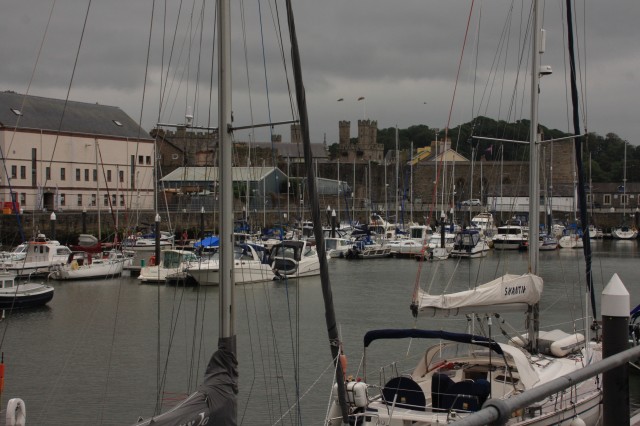
Arriving at Caernarfon by the marina with the castle towers in the distance
We began where left off yesterday in Y Felinheli, and after around four miles we arrived at Caernarfon, wending our way through the town and admiring its great ‘bastide’ walls until we came to the glorious pinnacle of Edward’s castle building ambitions.
Now’s the time to swallow a dictionary of superlatives, because you could easily throw all of them at Caernarfon castle and still have room for more. But there’s a reason for that. Caernarfon was to be Edward’s new administrative centre, the seat of his government and his power-base in Wales, and he wanted this castle to give out the strongest message yet to the Welsh; one of imperial rule in the Roman mould, linked with some legendary Welsh history, and with destiny itself.
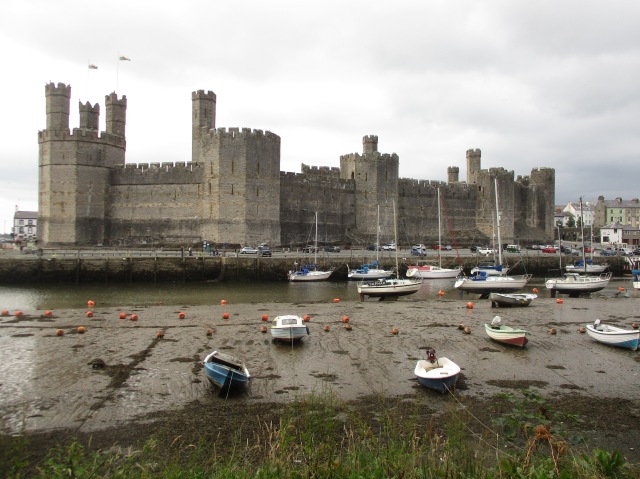
The castle in all its glory
Begun alongside its sisters of Conwy and Harlech in 1283, work again moved swiftly, and by 1287 the records of expenditure on the castle itself show more focus on the finishing touches, the fittings and furnishings rather than substantial building work. Edward and his queen, Eleanor, were on site in the middle of July and stayed for a month to watch their new castle begin to take shape. They stayed in specially constructed substantial timber-framed buildings, and Edward even had a pleasure garden created for his wife in the midst of the building site.
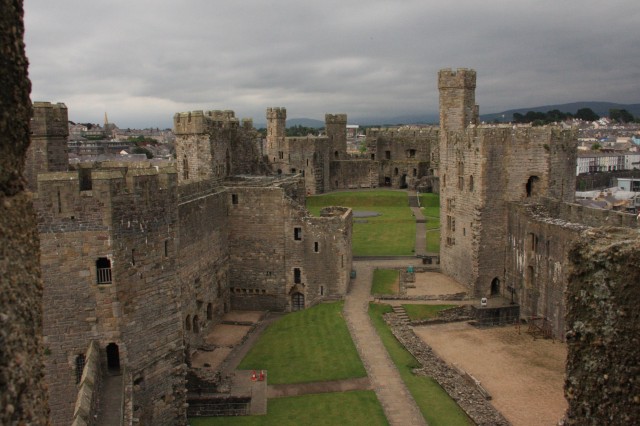
The interior of the vast castle, set out over two wards

One of the many intramural passages that run around the castle
Again the castle was located next to water, at the mouth of the River Seiont flowing into the Menai Straits. But aside from its sheer size, Caernarfon stands out in its symbolically-rich design. At his new headquarters, Edward took ideas of imperial Rome and built them into the fabric of the castle. The towers, unlike the king’s other works in Wales, are polygonal, decorated with banded masonry of different colours, a deliberate copy of the walls of Constantinople. Representing all the marks of the Roman emperor Constantine the Great, the striped angular towers reflected the realisation of Edward’s own imperial ambition. But he wanted to appear not just as a conqueror of a suppressed people, but as a ruler somehow plucked for the role by fate, as if the whole thing had all been written in the stars. And for this, he needed to weave in a tale from Welsh history.

The view from the top along the river
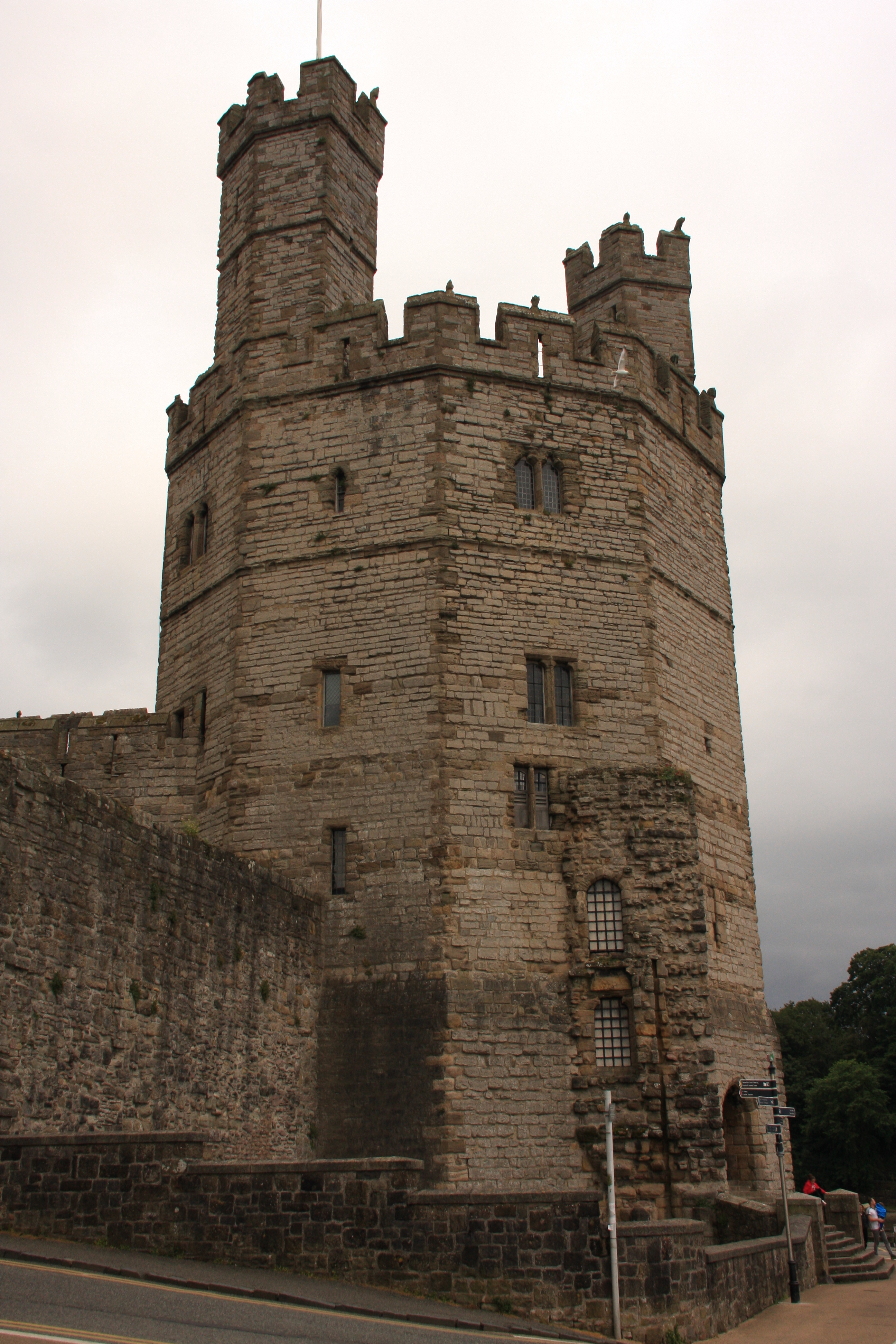
The great Eagle Tower, showing the banded masonry
For this, he tapped into a centuries’ old legend, the dream of Macsen Wledig. In this story, Macsen – the Welsh name for Maximus, the father of Constantine the Great – dreamed of travelling from Rome to a mountainous land with a river flowing into the sea. He came to a great fortified city, with towers of many colours and saw golden eagles beside an ivory throne. At Caernarfon, Edward had three stone eagles – perhaps even gilded – placed at the top of the turrets of the tallest tower looking out towards the sea. This was particularly creative, because the eagle was not only a symbol of the Roman Empire, but also a feature of this ancient Welsh legend. And as if that wasn’t enough, the king held an Arthurian ‘Round Table’ tournament near Caernarfon, aligning himself with another Welsh hero, and his own, King Arthur.
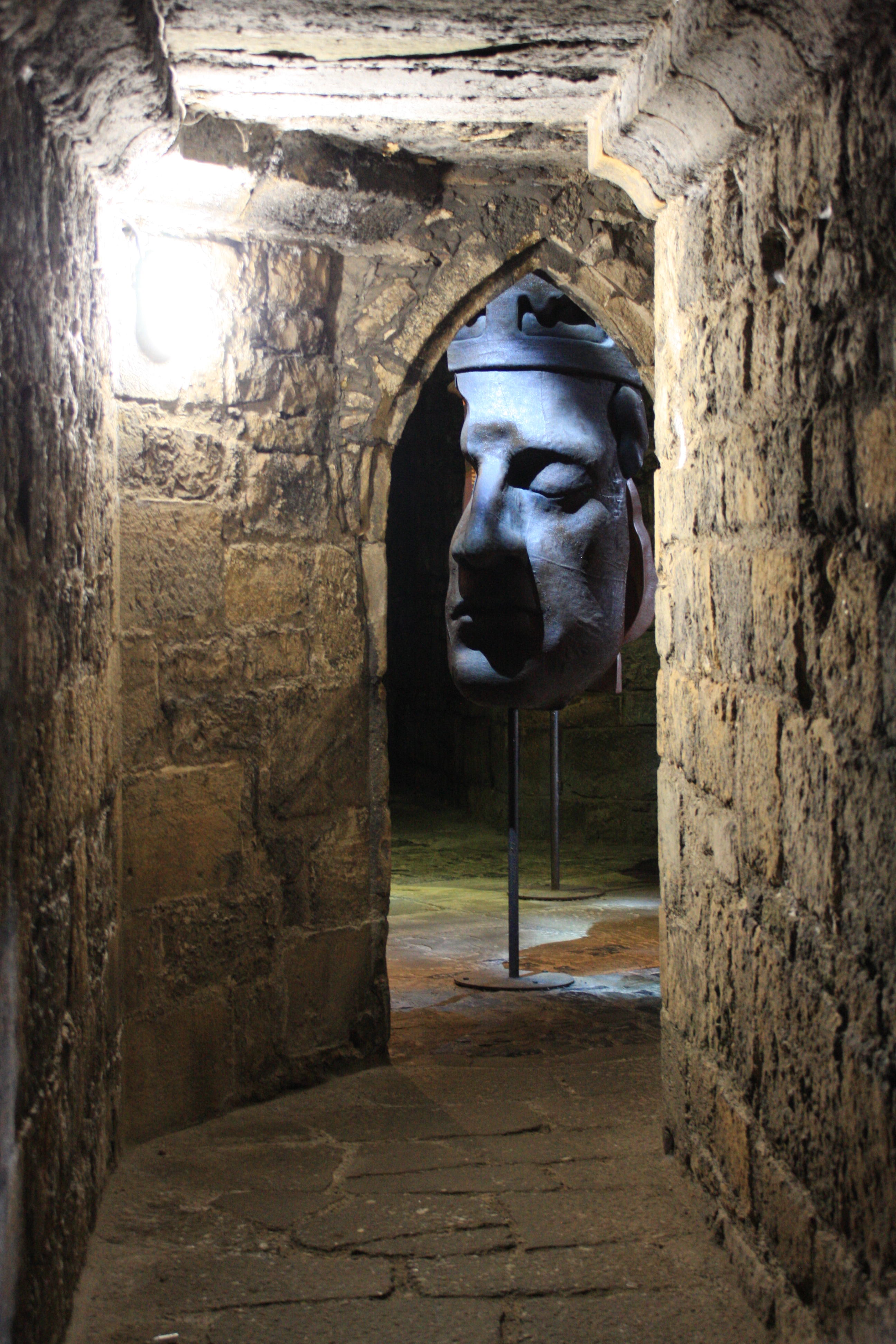
The dream of Macsen Wledig
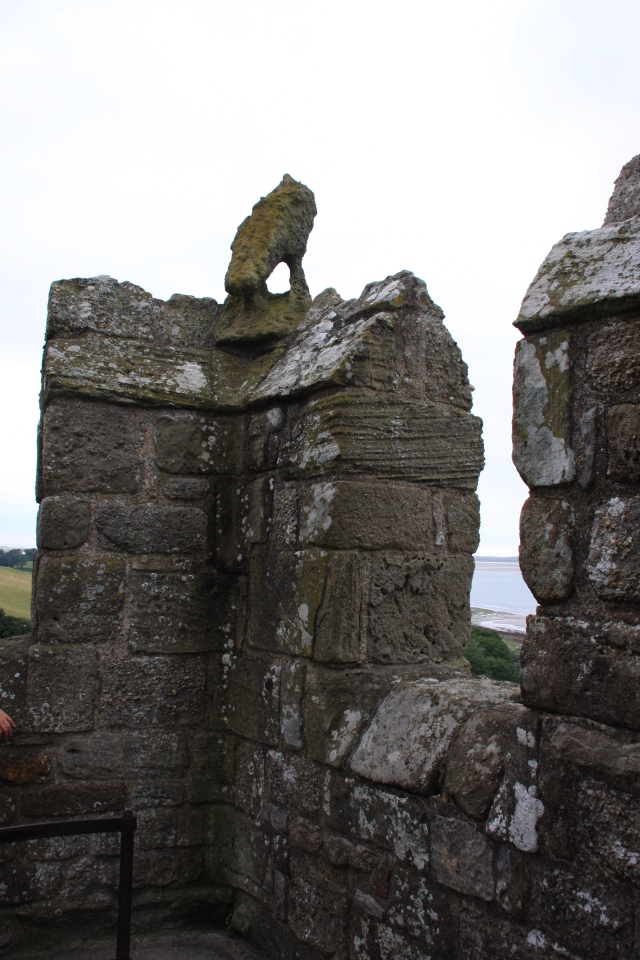
One of the worn stone eagles on top of the Eagle Tower, looking out to sea
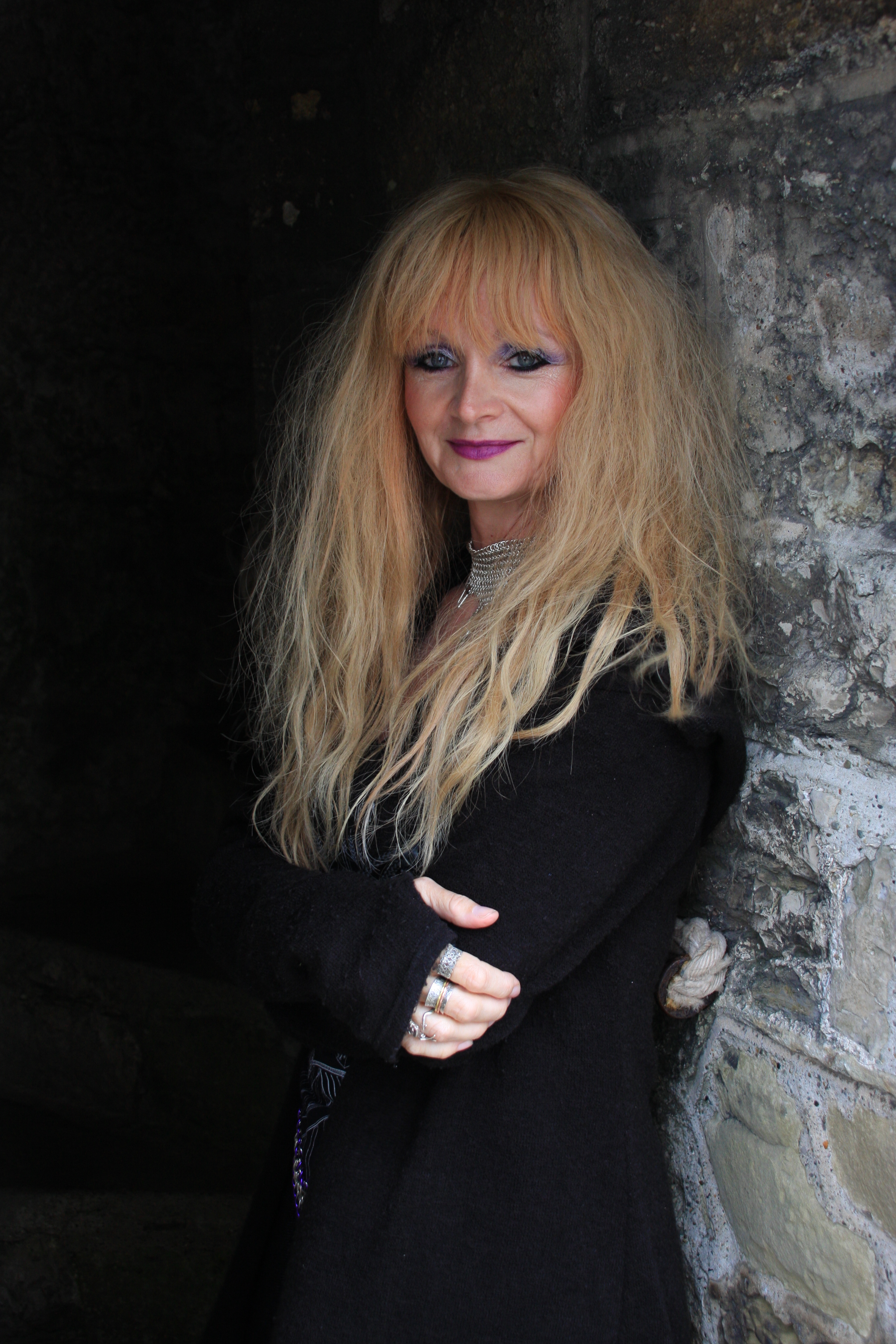
At the top of the Eagle Tower
But Caernarfon had another part to play in this tumultuous time, and that involves the much prized title of Prince of Wales after the ap Gruffudd dynasty had been eradicated. In 1284, the year after construction began at the castle, Edward and Eleanor returned to Caernarfon at Easter, where an event occurred that would take Caernarfon to an even higher status. And according to legend, Edward planned it that way.
The story goes that after the conquest, the Welsh nobility entreated the king to anoint a new Prince of Wales, who was “borne in Wales and could speake never a word of English”. So the wily Edward brought his heavily pregnant wife to Caernarfon, where she gave birth to a boy, also called Edward. Realising that his newborn son fitted the bill nicely, having been born in Wales and being unable to speak a word of anything, he presented his son to the nation as their new Prince. The young Edward of Caernarfon was formally created Prince of Wales at the age of sixteen, and from then on the title has gone to the eldest son of every monarch.
Within the vast complex of towers in the castle, the Eagle Tower is the greatest, not only because of its size and symbolism, but according to tradition it was a room in this part of the castle where little Prince Edward was born. The tower is entirely intact, with rooms hosting displays of the castle’s history and showing all the signs of comfortable living and service rooms associated with high ranking individuals, such as the king himself or his chief representative in Wales, his best friend Otto de Grandson.
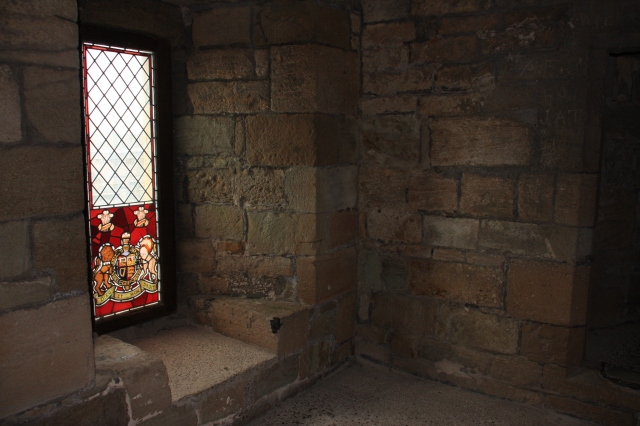
The room in the Eagle Tower that’s the supposed birthplace of Edward of Caernarfon, the first English Prince of Wales
Another striking feature is the castle’s hefty defences. The main entrance, known as the King’s Gate, presents any attacker with a deadly obstacle course to tackle in order to access the inner wards. In its fully completed state, which it didn’t quite reach, breaking into Caernarfon in the 13th Century would have involved getting past two drawbridges and six portcullises whilst dodging the murder holes above before turning hard right to gain entry without getting killed. Unlikely. Another notable feature is the ingenious angled arrow slits, which meant that defenders could shoot in different directions through one opening, providing the widest possible shooting range.
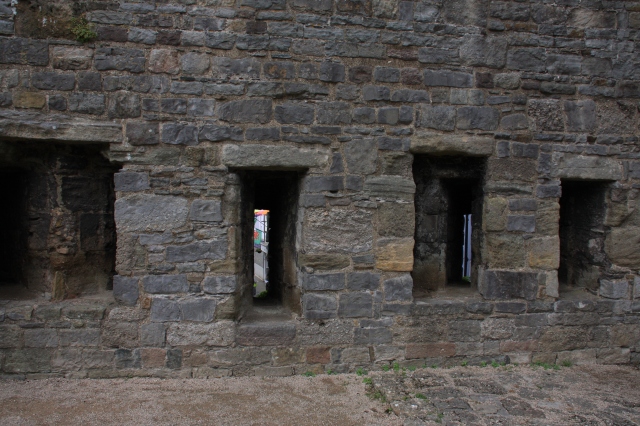
Angled arrow slits provide a wide shooting range…
However, despite all these heavy defences, the castle wasn’t immune to attack, especially while it was still being built. During the 1294-5 uprising led by Madog ap Llywelyn, Caernarfon was trashed when the rebels broke in through the incomplete northern side, and we can still see the response to this attack in the walls today. When the castle was retaken by the English, the priority turned from symbolism and elegant banded masonry to fast fortification, so the northern walls have a more rustic look, monotone in hue, as though they’ve been thrown up in a hurry. And that’s precisely what happened.
Caernarfon has everything to offer the intrepid Castle Quester, and more, and no time there is ever enough. In the end, of course, the staff annoyingly wanted to go home, so I had to tear myself away from the jewel in Edward’s imperial crown. Still, it’s onwards and upwards again, and tomorrow it’s literally upwards as I take to the skies to fly over and photograph Caernarfon, and the penultimate castle of my Quest – the beautifully-positioned Harlech…
Another great and interesting post my Love – It was a great day today and I really enjoyed exploring the castle with you, I love all of those passageways and towers.
Looking forward to tomorrow! (More Pimms please!)
LikeLiked by 1 person
AFTER the flight..!;-)
LikeLiked by 1 person
Well of course!!! 😀
LikeLiked by 1 person
You can’t take very good pictures flying upside down… 😉
LikeLiked by 1 person
LOL!!! That’s what photoshop’s for!
LikeLiked by 1 person
The castle is so grand! So big and beautiful! Interesting to learn of the birth of Edward, his future and to see where he was born – wow! Such history. What a magnificent journey!
LikeLiked by 1 person
Thanks Robyn. It’s a truly amazing castle with an equally amazing history. Thanks for reading. 🙂
LikeLiked by 1 person
Talk about memories! It just reminded me of the entire day we spent exploring that castle. It was huge. I was later told that there was at one point a complete town inside the walls, that it wasn’t just a castle but the walls of a town. It certain is big enough.
LikeLiked by 1 person
That’s right, it is huge, and hopefully I’ll show the walls from the air later. Glad to have brought back good memories for you. It’s a very special place indeed. 🙂
LikeLike
The pinnacle of the quest so far for me. The castle, your story and the photos. I think this blog shows how those exam results gave you that extra bit of encouragement – not that you needed any. Can’t wait for thoe aerial pictures.
LikeLiked by 1 person
Thanks Malc, that’s very kind. It was the pinnacle for me too so far, but I am looking forward to getting airborne in a couple of hours! Results later… 🙂
LikeLiked by 1 person
Great photos, Alli, and great commentary. The statue of the dreaming Macsen Wledig is fabulous. x
LikeLiked by 1 person
Thanks Sue. It looks so ghostly as you approach along the darkened passageway. I had to get a picture of it. Glad you enjoyed our visit. 🙂
LikeLike
I can imagine. I never went inside that one so I am glad to have shared your visit 🙂
LikeLiked by 1 person
The Prince of Wales thing is interesting. Edward of Caernarfon wasn’t Edward I’s first son and his own first son, Edward III, was never made Prince of Wales. I’ve always thought it a shame that the legend isn’t true.
LikeLiked by 1 person
Hi April, yes Edwards’ eldest son was called Alfonso, but he died a few months after Edward of Caernarfon was born. He grew up to be Edward II and Edward III was his son, so Edward 1st’s grandson. 🙂
LikeLike
He must have quite liked his wife then if he had a garden made for her! 😉
LikeLiked by 1 person
He did – he adored her. 🙂
LikeLike
Wonderful post, Alli. How inconsiderate of the staff to want to go home though!
LikeLiked by 1 person
That’s exactly what I thought! Glad you enjoyed it, Albert. 🙂
LikeLiked by 1 person